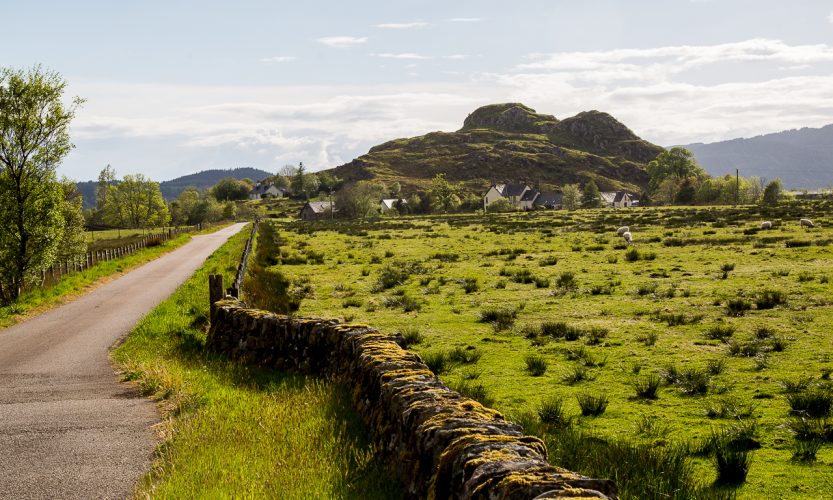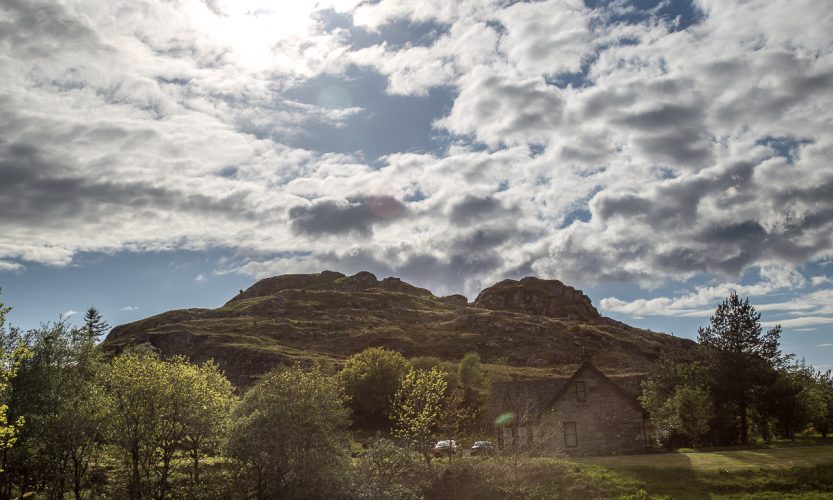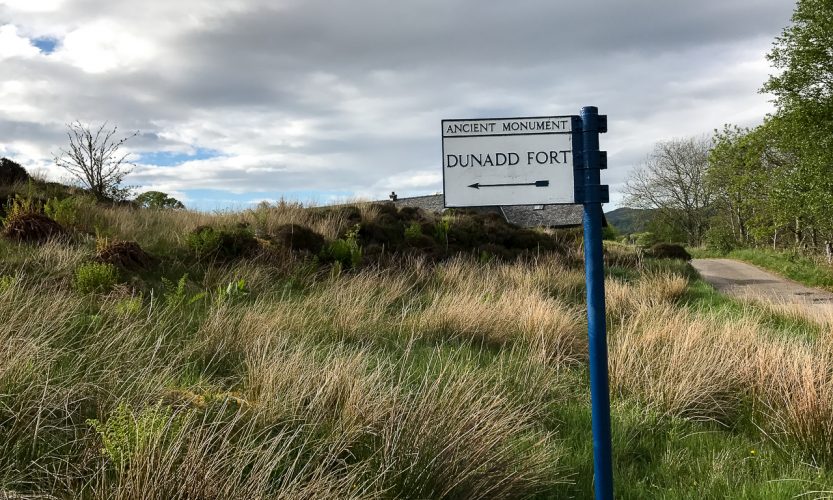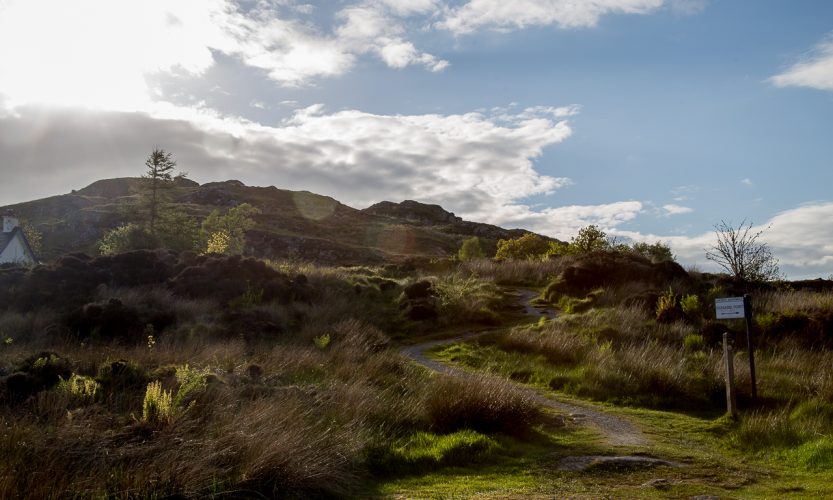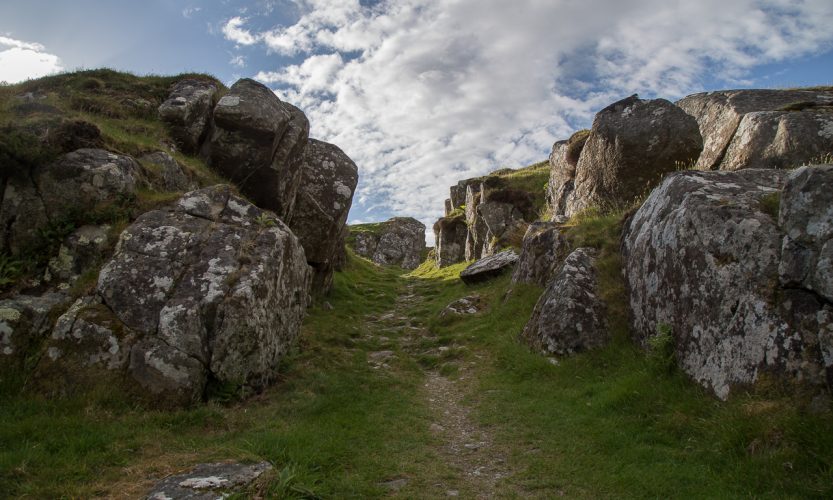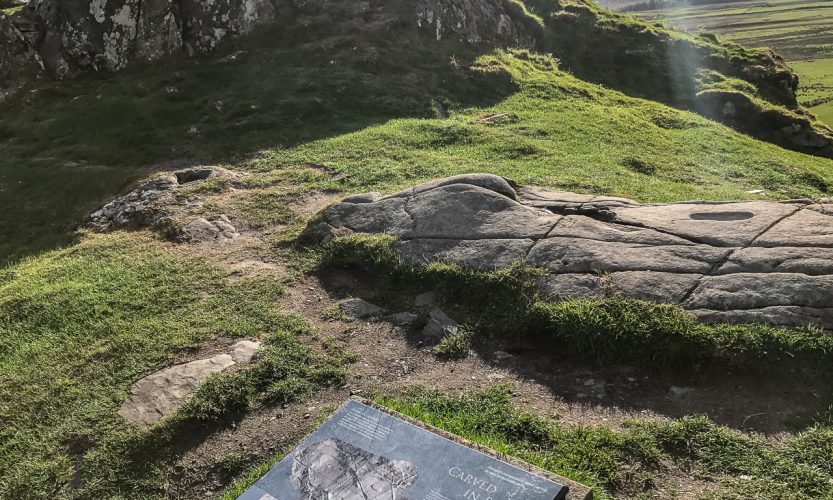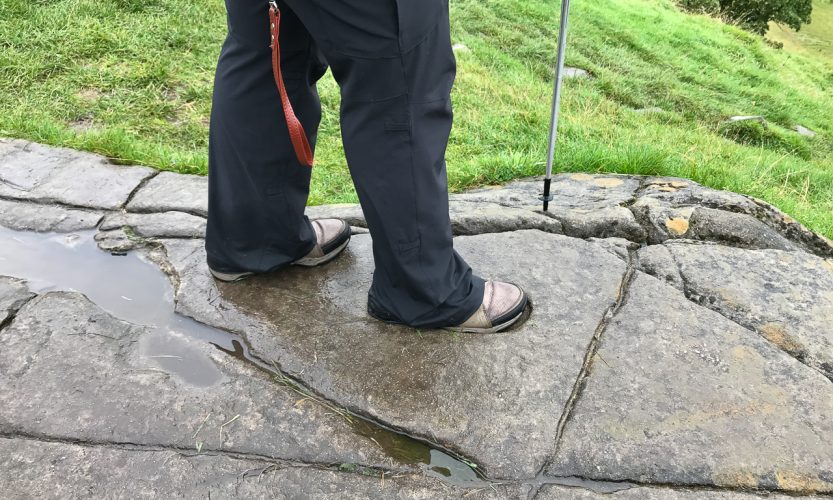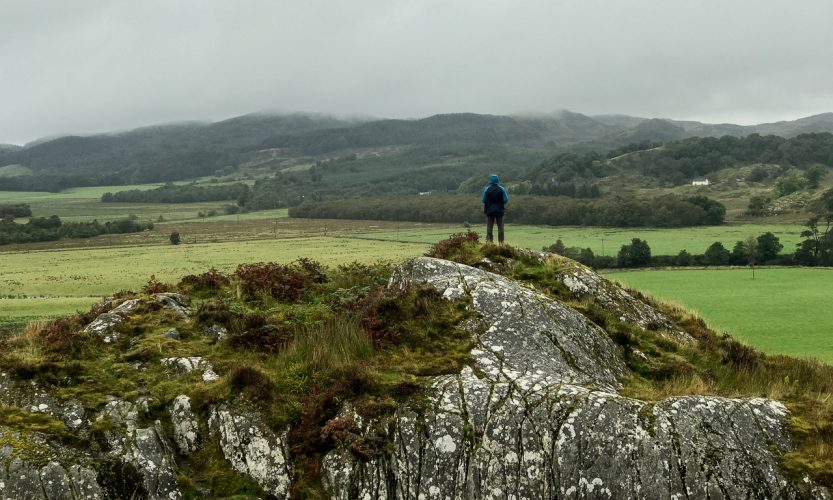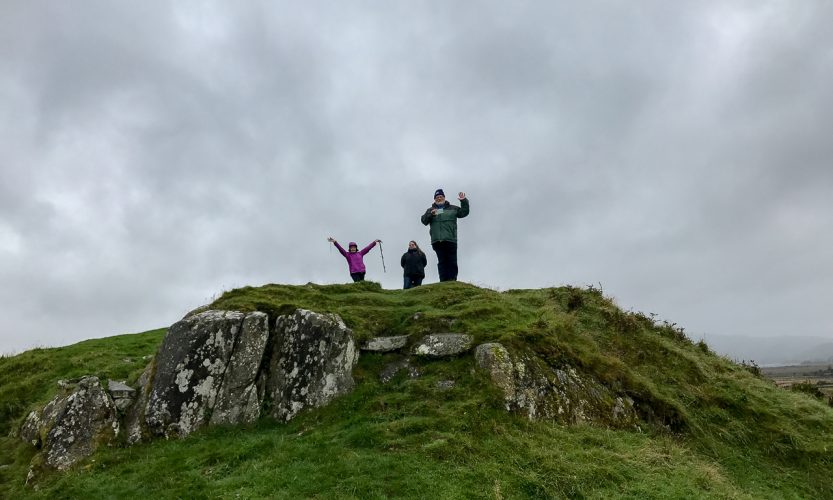Best Ireland Guidebooks 2018
Our picks for Best Ireland Guidebooks – 2018
After reviewing 12 general travel guidebooks on Ireland from publishers that included Insights Guides, Moon Guides, Fodor’s, Frommers, Lonely Planet, National Geographic, DK Eyewitness, Michelin and Rick Steves our team has come up with our Top 3 General Guidebooks and our #1 pick for specialty guidebooks for 2018.
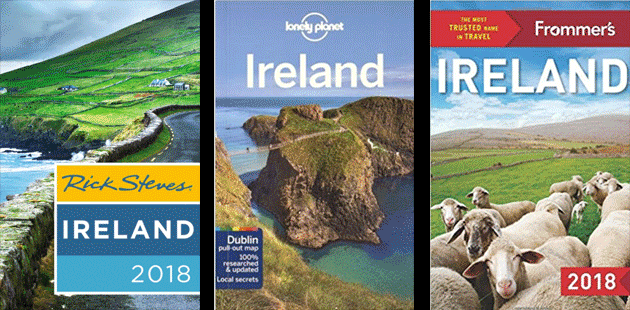
INVEST IN A GOOD GUIDEBOOK – If you think about how much a guidebook costs- $20-$25, that’s the cost of a nice lunch in Ireland. One guidebook can make such a difference in planning your tour and enriching the experience once you’re at a sight. Do yourself a favor and pick up a guidebook or two before you take your trip. We’ve also got links for Books to read before you go to Ireland and Best recommendations for maps and apps.
Top 3 Ireland Guidebooks for 2018
 #1 Rick Steves Ireland 2018
#1 Rick Steves Ireland 2018
Rick is still our #1 choice and it’s not surprising that he is the #1 guidebook author in the world. His Ireland guide is the #2 best-selling guide on Ireland listed by Amazon (#1 is Lonely Planet’s 2018 guide – our #2). We like Rick’s Ireland guide because it’s the best book about general Ireland stuff with in-depth information on the sites covered. Because Rick Steves is a historian, his commentary on sites that he does cover is so thorough and rich, which makes the visiting experience so much more meaningful. His commentary on Dingle alone is worth the price of the book. He writes as if he is right there with the visitor, leading and guiding the tour. He also offers excellent commentary on the Burren, Galway and a near 40-page chapter on Irish history, language, and slang. All of Rick’s guidebooks are updated every single year.
We’re also excited that our friends – and favorite guides Dingle – Kevin O’Shea and Claire Glavin of Celtic Nature Walking Tours – are featured in Rick’s Dingle section. Kevin is also featured in episode 5 of our Thin Places Travel Podcast
Another perk of this book is that there is a pull-out map in the back. Several guidebooks have maps included but this book has the country map on one side and then a blow-up of 5 cities including Galway, Dublin, Belfast, Derry and Dingle AND the map can be used while still attached to the book, so it can be kept with the guidebook and not lost.
What we don’t like is that if Rick doesn’t like the site, he doesn’t include it. So you may want to look up a particular site and find that it’s not included. But the quality of what he does include is too good to not have the book. So a second guidebook that more like an encyclopedia (covers almost all of the sites) is needed. Which is why we recommend the next two books from Frommers and Lonely Planet.
Rick Steves Ireland 2018 is worth the $23.99 retail price just for the commentary on Dingle, Galway, Belfast and the Burren, which is no wonder it is rated #1 in Amazon’s travel books on Ireland for general interest. It’s also rated (today 3/25/18) as #479 in ALL books listed on Amazon (estimated to be in the millions). If you follow the consumer, this is the book people are buying.
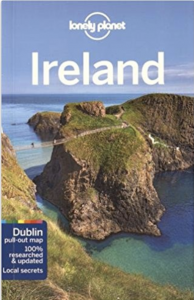 #2 Lonely Planet’s Ireland Guide
#2 Lonely Planet’s Ireland Guide
Personally, I love Lonely Planet’s publications and love Fionn Davenport (one of their Ireland writers) even more. This guide is included in our Top 3 not because it’s more comprehensive than any other guide, but because of the uncluttered, organized and casual layout Lonely Planet guides offer. Their books are simple and easy to use. This book also features a Top 21 site list and a First Time in Ireland section, maps, suggested itineraries and a section on The Great Outdoors. In years past, Fionn Davenport offered such a unique, casual style – a great storyteller. Though the editors have tightened up on his entertaining, casual commentary, Fionn’s style still shines through. This is still the first guidebook I reach for when looking up sites in Ireland.
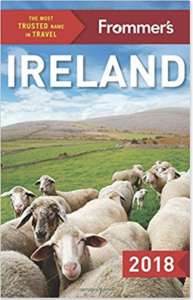 #3 Frommer’s Guide to Ireland 2018
#3 Frommer’s Guide to Ireland 2018
Before this year, we weren’t big fans of Frommer’s. But they’ve outdone themselves with this year’s guide to Ireland. There’s great information about the country, the culture and what to expect as well as a comprehensive listing of most interesting general sites throughout Ireland and Northern Ireland. It’s both comprehensive and diverse with suggested itineraries, maps and a whole section with the “Best of…” lists including Best Castle, Best Natural Wonders, Best Literary sites and Best Museums. This guidebook has serious “personal” appeal. It seems they’ve written it in a “peer perspective” rather than an authoritative perspective. It’s what people want these days .. the personal recommendation of peers. The book also has a compact, tear-out map that has a “town key” so you can easily locate the region of most towns. This would be our #2 recommendation for a comprehensive (all inclusive guide) to Ireland.
#1 Specialty Guidebook – Thin Places Focus
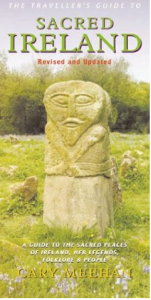 #1 Specialty Guide – Sacred Ireland, by Cary Meehan (out of print – but available on Amazon from Used book dealers – pricey but worth it)
#1 Specialty Guide – Sacred Ireland, by Cary Meehan (out of print – but available on Amazon from Used book dealers – pricey but worth it)
It’s not often that we highly recommend an out of print book, but this year a buyer can at least obtain a used copy from book dealers out there. Even though the copies run $60 and above, this is the best resource for thin places and sacred sites of high energy. Last year there were none to be had. If you can snag a readable copy of this for under $100, do it. It reads like a guidebook with the sites grouped in counties and provinces with a map for each county showing the approximate location of the sacred sites. Even the smallest stone circles, standing stones, and holy wells are mentioned. It was in this book that we found The Giant’s Ring in Belfast (not mentioned in any guidebooks I’ve seen), and it’s an amazing site – a large dolmen set into an earth-work ring that now serves as a public park just outside the city center. The majority of the sacred sites and megaliths in this book are not listed in any guidebooks or on maps. It would take someone years to pull together a list like this. Cary Meehan also writes from a mystical perspective so those seeking the thin places will greatly appreciate her commentary and includes directions (I never depend on these, but they’re a good estimation). If you love thin places, this guidebook is a gold mine. Grab a copy while you can.
Honorable Mention
I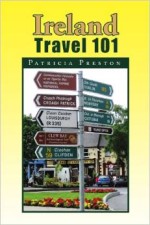 reland Travel 101 by Pat Preston
reland Travel 101 by Pat Preston
If you ever wanted to pick the brain of an expert on travel to Ireland, you’ll enjoy this book by Pat Preston. For years she worked for the Irish Tourist Board and later had her own tour operation bringing visitors from America to Ireland. Sadly, Pat has passed away, but she left a worthy legacy in this guidebook. She begins the book with all the tips and information people want to know – how electricity works, how to get around, how to plan your trip, what to take… then she highlights various regions offering her personal recommendations for attractions, accommodations and food based on years of experience. I love the sections “If You Have More Time” as options for attractions and sites that are somewhat off the radar. I could do a whole trip with just those recommendations. A very worthy book to have in any travel library.
I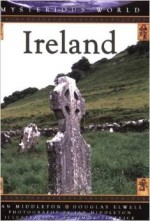 reland from the Mysterious World series, by Ian Middleton
reland from the Mysterious World series, by Ian Middleton
This book is similar to Cary Meehan’s Sacred Ireland in that his lists megaliths and places of mystery. Ian Middleton is a great historian and has laid out the book well. There are also color photographs of the sites which are fabulous. The sites are laid out according to counties so it’s easy to pick add on sites in an area based on what the inventory is. This book offers a good inventory of mystical places. Where Cary Meehan focuses on the mystical nature of a site, Ian Middleton (in this book) focuses on the site’s connection to Ireland’s legendary past.
Biggest Guidebook Dud
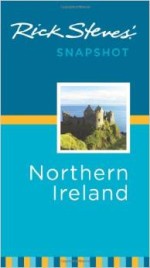 Rick Steves’ Snapshot – Northern Ireland
Rick Steves’ Snapshot – Northern Ireland
Though we love Rick Steves, we’re rating his Snapshot of Northern Ireland as a Guidebook DUD not because it’s content isn’t valuable, but because the title is misleading. Rick’s “snapshot” books are merely sections lifted out of the full guidebook so people who only want a small portion can have just that piece of the book. In this case, there just isn’t enough representing this small country of Northern Ireland, and the content pretty much follows how the Irish Tourist Board markets Northern Ireland – Derry and the Antrim Coast with a little of Belfast for good measure.
There are four of six counties left out of this guidebook. It mirrors exactly what the Irish Tourist board (the Republic of Ireland) markets about Northern Ireland. There is so much more. It might have been better to do a “northern snapshot” and included Donegal and Sligo.
To be fair, the content Rick includes on the history of Northern Ireland and the difference in countries, government and currency is valuable. But one could get that same information in most guidebooks – and on Rick’s blog.
Read other posts in this series on books
Books to Read Before You Travel to Ireland
More Books to Read for Travel to Ireland
The Man in the Sand in the Shadow of Mount Brandon
A Man in the Sand Appears on the Beach near Mount Brandon in Dingle
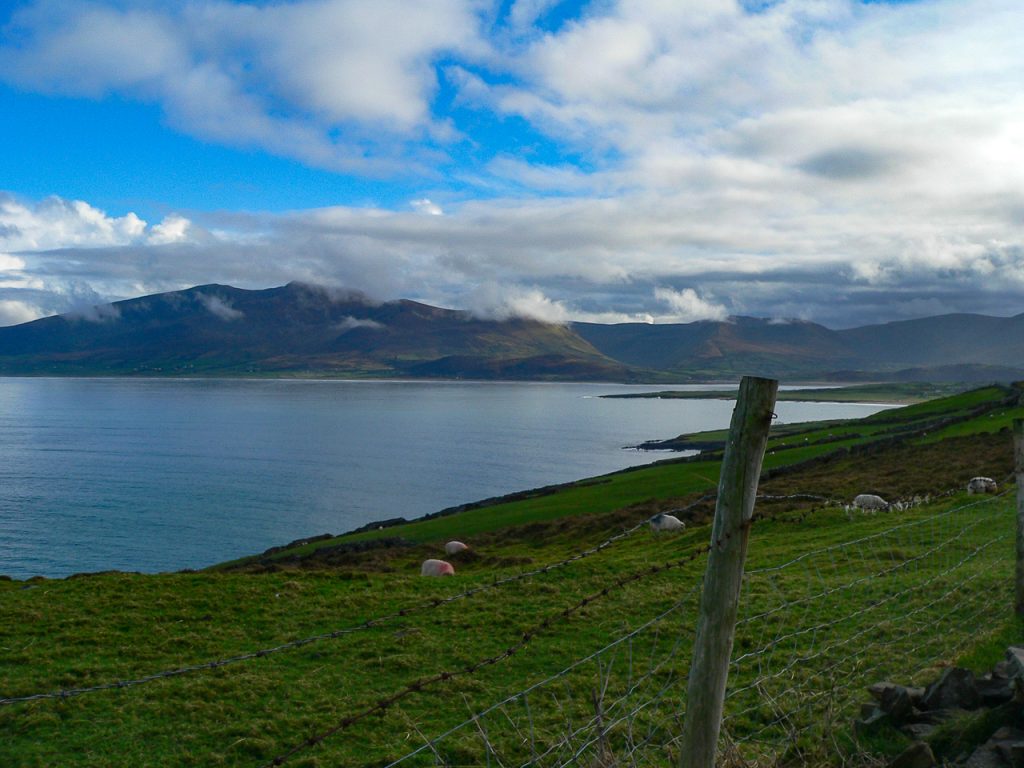
On a dreary February day many years ago, I was traveling alone in Ireland, doing some research for some writing I had to do on thin places in Ireland. Most of this day was spent on St. Brendan the Navigator who was born near Dingle and is a local heroic figure. I visited Ardfert, his first monastery, then Mount Brandon – the holy mountain named for him.
I was in a bad place personally when I wrote this travel journal entry. I’d been working on completing this book for years and I couldn’t move myself forward. No amount of research could push me to completion. Every time I started, I stopped. I had no confidence – filled with self doubt.
This was also a day of miracles – or coincidences. There’s something different about praying in a thin place, though. If you listen hard enough, sometimes you hear an answer or get a sign. This a day for one of those knock-you-in-the-head burning bush signs.
Travel Journal entry – February 20, 2009 – Ireland, Co. Kerry
Mount Brandon – coming from the north road into Dingle after passing the exits for Castlegregory, I came to Fermoyle strand. Mount Brandon dominates the landscape on all the north roads.
Mount Brandon is the second tallest mountain in Ireland and at its base, St. Brendan the Navigator is said to have launched his fleet of curraghs to set sail for the Promised Land as revealed to him in a vision. Prior to the voyage, he spent time on this holy mountain-top in reflection and prayer similar to St. Patrick’s retreat on Croagh Patrick. Also similar to Croagh Patrick, it’s likely that both holy mountains were considered sacred by the local people long before Christianity came to Ireland.
To say the scenery here is breathtaking would understate. It’s magical. The dismal sky and drizzle offered a blue-gray backdrop, but allowed just enough sunlight to illuminate the vivid green fields dotted by sheep at the base of the mountain. Down on the strand the wet sand at the shore is firm – almost like slate. The waves rush in and then Atlantic sucks the surf back out almost a half a mile – leaving various shapes in the flat sand. I was the only one on the strand. The only human image in that landscape.
I pulled into a little car park for people walking out to the beach. It started to rain buckets. So I sat in the car for awhile reading over notes and other authors’ writing about thin places in Ireland. I opened up an article by a well-known author – one whose work had appeared on the New York Times Best Seller list. Though I loved this author’s works of short fiction, I was disappointed in how sappy and trite this piece on thin places was. The writer overtold the meaning. The work left me feeling the writer was trying more to project a sense of spiritual superiority than remark on the mystery of a thin place.
I’m so judgy.
I thought to myself, “how is it that this successful author can get stuff like this published about this places, and I can’t write a word?”
Rain stopped. I continued my indulgence in self-pity as I walked out onto the strand. The tide was out and the sand seemed to stretch on forever. Mount Brandon dominated the landscape. I noticed a pale light hanging it illuminating a very low, wispy cloud just touching the peak. I was then then I stepped into the moment – feeling no passing of time… just being.
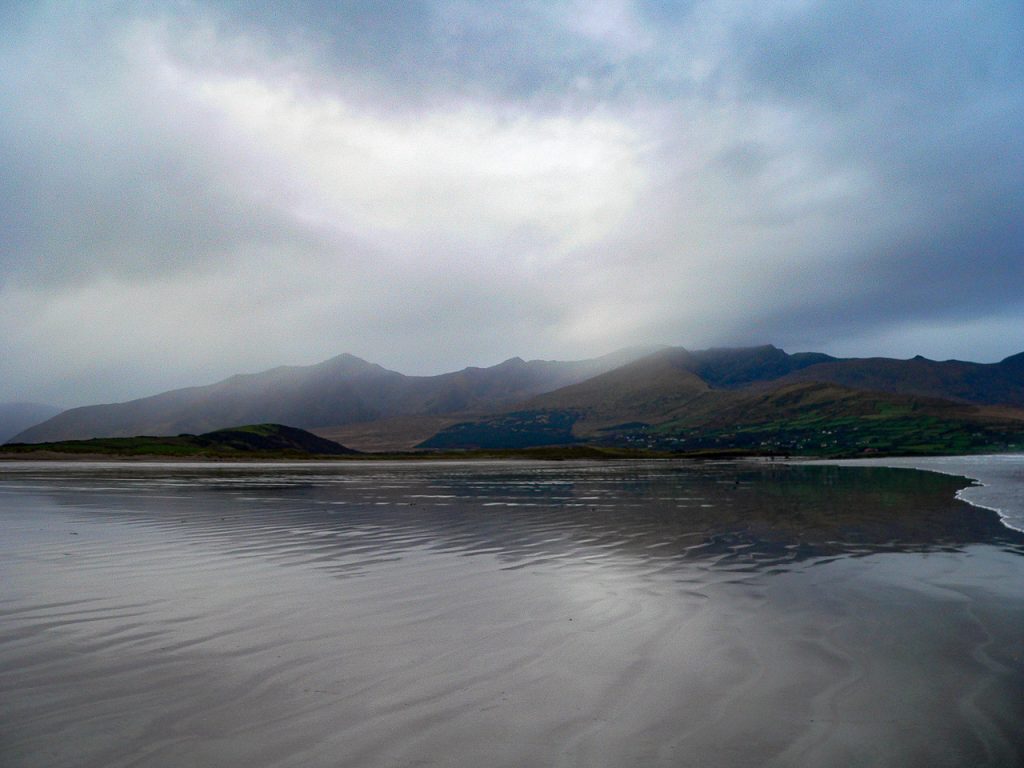
With a great sense of inadequacy, I turned to God, or whoever might be listening and said, “I can’t write. No matter how hard I try. I can’t write.”
My one-sided conversation was pretty anti-climactic. But then I looked down at the sand. There was an image created by the receding waves. It seemed to have a head, body, legs, and its right hand was extended with what looked like a flower or a box or something. It looked like a faceless man in a cloak. I thought, “Am I really seeing that? I’m just imagining that it looks like a man in the sand. But it didn’t wash away or fade away. So I started snapping pictures.
Even after fifteen minutes the man in the sand was just as clear as he was when I first noticed him. At times like this, I guess we try to find meaning. Was it a sign? Did it mean something? If so, what? I was reluctant to ascribe any meaning to the man, but it sure felt like …. something.
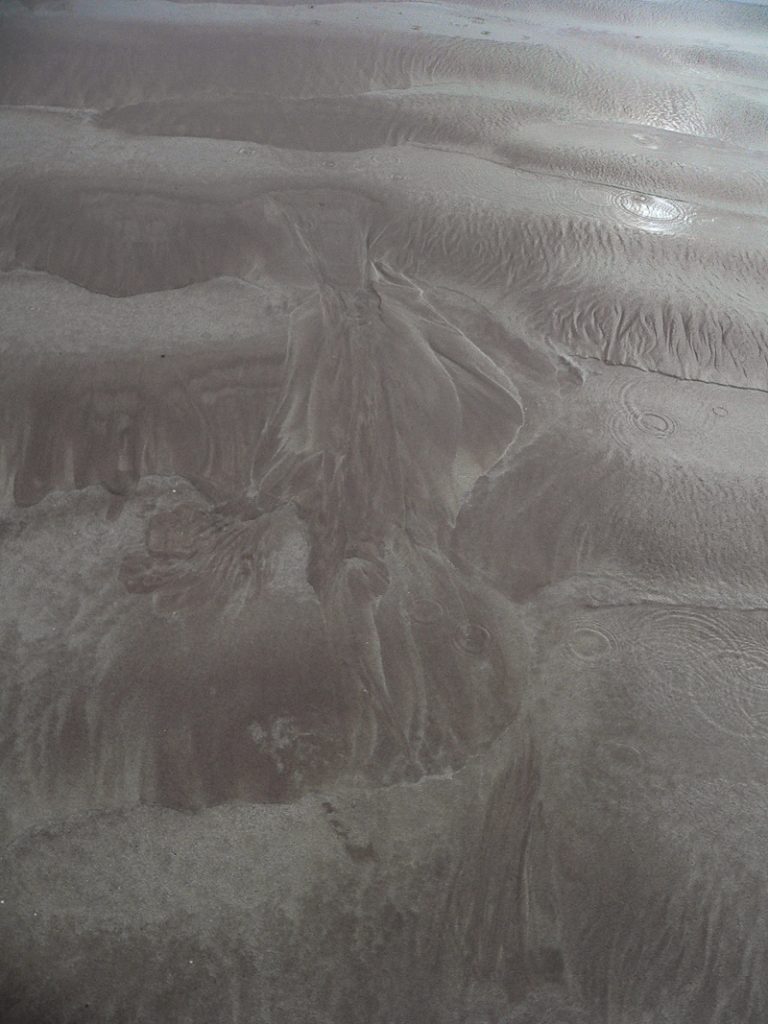
It was surely a synchronistic moment.
Caitlin and John Matthews remind us that we communicate with our five senses in the physical world, but we communicate with our spirit in the spirit world. They also give us insight on how to perceive coincidences moments of synchronicity – the simultaneous occurrence of events that appear significantly related but have no discernible causal connection. Here’s a quote referencing this from their book, Walkers Between the Worlds.
“… synchronicity… is actually an instance of an exact match between the fabric of our world and that of the Otherworld. While we normally dismiss such an occurrence as coincidental, in looking more deeply we can see the exact correspondences between one world and the other.”
After I was done with my man in the sand, I turned to leave. I was headed by car to the foot of Mount Brandon. There’s a road that winds around past Brandon village and ends at a place called Ballydavid north. It’s as far as you can go around Brandon Bay and the road ends at a little car park where one can take off up the mountain on foot. The rain was coming back and about to pour. The sky was black. As I turned to leave the beach I notice a bright ribbon of a rainbow in the eastern sky. Wow.
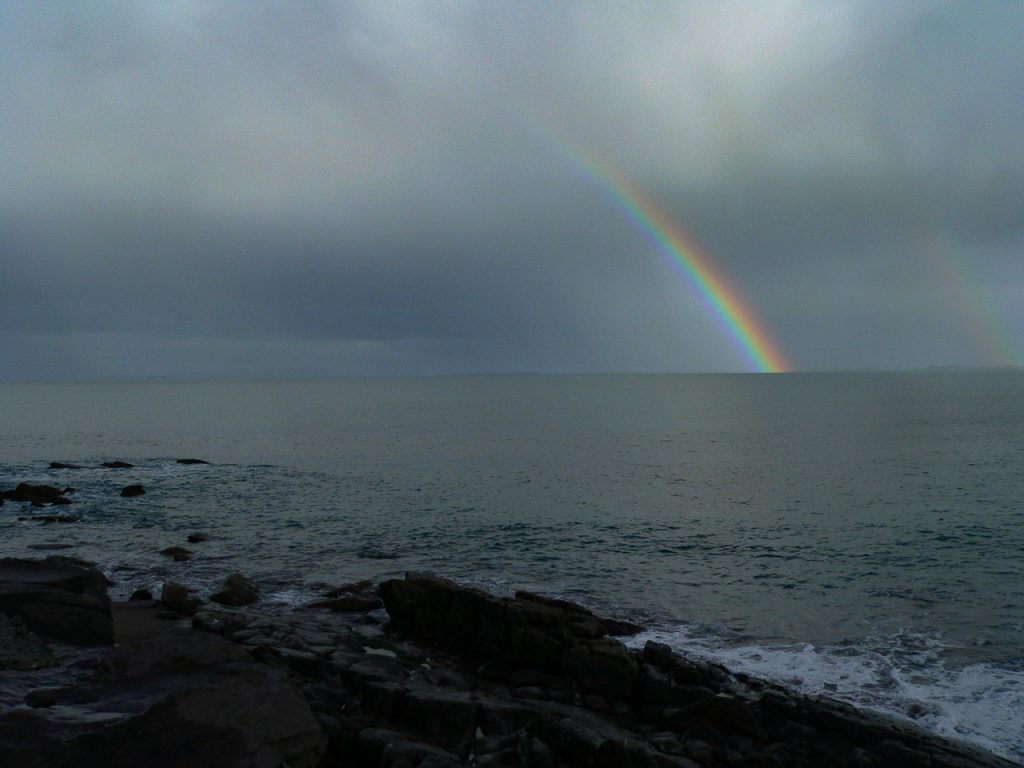
Another sign? Maybe. Maybe another coincidence.
I got to the car and headed out. For 20 minutes I drove and for 20 minutes that rainbow followed me. It was still there when I got to the foot of Mount Brandon. And I stayed there another twenty minutes as the rain fell and the sky cleared … watching it fade away. What a day.
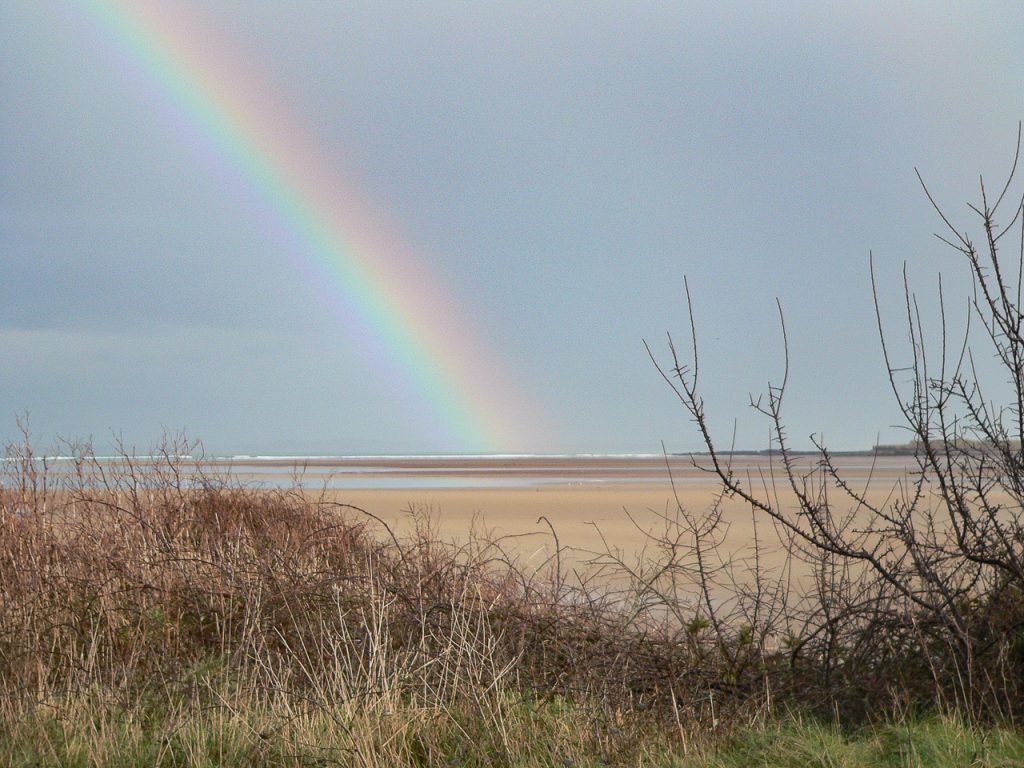
The eternal world or spirit world or Otherworld is one side of reality while our physical world is the other. But together they show us one world, one reality. A thin place brings us face to face with these two sides of one reality, and our prayers – our conversations with the Creator are whole and enjoy a sense of completeness.
Fermoyle Strand and Mount Brandon are thin places. At the time I was experiencing the above-mentioned synchronicity in Dingle I didn’t understand what any of it meant. Thus the importance of journaling and taking photo images. As we grow in spirit, so does our understanding.
And when I got home … I couldn’t stop writing. I’m still writing.
Dunadd Fort – Kilmartin Glen
Dunadd – Ancient Royal Center – Kilmartin Glen
The remains of Dunadd Fort in the Kilmartin Glen in Argyle, Scotland rise out of the Glen like an old boulder dropped from the heavens. Everything around it is flat – and then, there it is. A lumpy hill that is perhaps 4 stories high sitting in a landscape that houses over 300 ancient monuments – the largest collection in all of Scotland. This was the 6th century political and ritual site where the first Scottish Kings were crowned, and where they ruled from. Here is a one minute video showing the path from the valley floor to the Citadel.
This site not only has an ethereal feel at the top, it vibrates with ancient, almost celestial energy. The spiritual energy is almost overwhelming when one climbs to the top alone. The entire ascent to the top becomes a walking meditation.
The Kilmartin Glen
The Kilmartin Glen has over 300 ancient monuments in a few square miles. Dunadd is one of them and situated at the end (or beginning) of a linear trail that holds most of the megalithic structures.
When I set out to explore the ancient monuments, I was looking for the stone circles, the standing stones, the tombs, the rock carvings. As I up the A816 from Lochgilphead I knew that I was coming into the Glen and was watching for directional signs to the monuments. I happened to look left and saw this lone, rocky hill and thought how strange it was to be situated there in all of that flatness. Then I saw the signage for Dunadd Fort and realized that this rock in the middle of the Glen was, in fact, one of the monuments.
Ancient Seat of the Early Scottish Kings
Though fortifications of this fort go back 2400 years, the hill’s use as a royal site and political center run from about 600 to 750 AD. This was the royal seat of the Dál Riata tribe. They had a common language and culture with the Ulster tribes in the north of Ireland. The descendants of this tribe were the Scotti (the name Scotland derives from this group).
Though it looks like a lumpy rock, it was once fortified with a protective rampart there were also dwellings, a well that served the entire community on the rock and even an industrial center where jewelry was made for royalty and the social elite. Up at the top of the rock was the site where royal rituals took place.
The Inauguration Stone
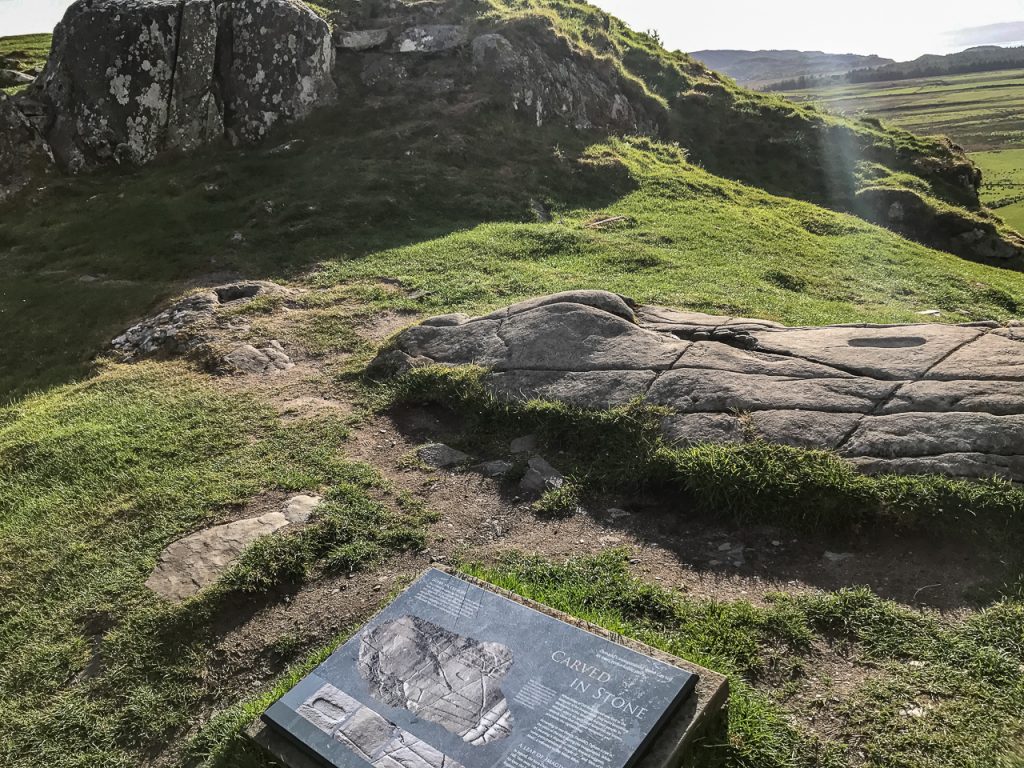
The most impressive artifact remaining on the site is the Inauguration Stone. At the top of the hill (at the lower elevation) is a flat stone with a footprint carved out. There is also ogham writing on the stone and other writings believed to refer to sacred rituals. The candidate for king would be brought here in a procession and a ritual would be carried out on this spot where the pending king would place his foot in the footprint on the sacred stone signifying that he was married to the land – and hopefully this marriage between king and land would yield fruitful harvests and a blessing on the people.
The actual stone used in the 7th and 8th century lies beneath the one we see currently at the crest of Dunadd. A concrete replica was placed overtop the original in order to protect the original stone. But it gives the visitor a glimpse of what the actual stone looked like in this place.
I snapped a photo (pictured above) of the stone and noticed later that a beam of sunlight was shining directly on the footprint. It was a magical time up there all by myself.
The Citadel at Dunadd.
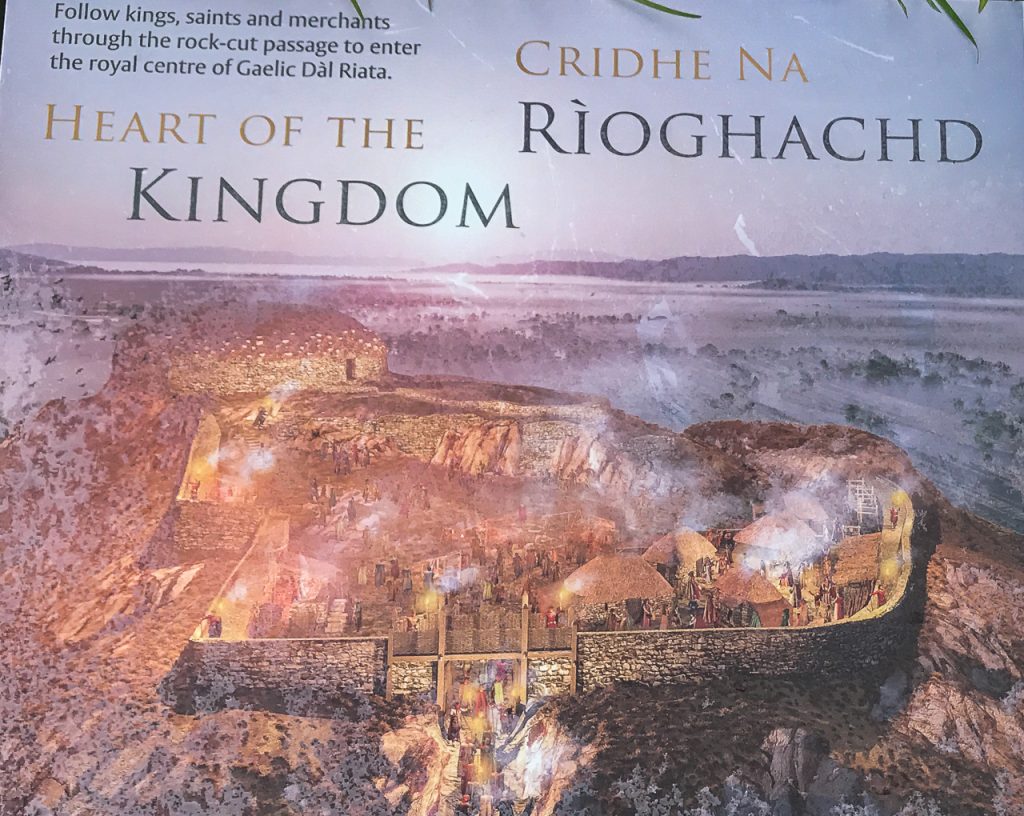
Image of what the Citadel may have looked like.
Directly above the Inauguration Stone at the highest point on the hill, is a slight rise to a flat terrace level. Researchers believe this was a citadel – an enclosed building where political discussions were held. It was the governmental meeting place situated perfectly at the top of the hill.
The panoramic views from this plateau are stunning and take in all of the Kilmartin Glen which sits on the banks of the snaking River Add. The island of Jura can be seen in the distance. Iona is only 35 miles away.
St. Columba and Iona
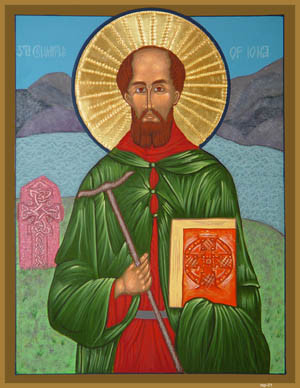 The Irish have a wonderful tale about the self-imposed exile of St. Columba. After his prideful actions caused a war between Irish tribes that cost lives and treasure and brought sorrow to the people, Columba got in a boat with twelve followers and set out from Derry heading for a new home. He stopped at the first island he came to where he could no longer see his beloved Ireland and that was Iona where he founded (started) Christianity in Scotland.
The Irish have a wonderful tale about the self-imposed exile of St. Columba. After his prideful actions caused a war between Irish tribes that cost lives and treasure and brought sorrow to the people, Columba got in a boat with twelve followers and set out from Derry heading for a new home. He stopped at the first island he came to where he could no longer see his beloved Ireland and that was Iona where he founded (started) Christianity in Scotland.
Scottish historians believe that Columba negotiated with King Comgall in about 563AD to use Iona for the founding of a monastic community. That negotiation would have most likely occurred in this Citadelidel on the top of Dunadd Fort. Remember these Argyle tribes were related to the northern Irish. They spoke the same language and shared an ancestral history. It’s likely that the King would benefit by having Columba found a monastery because monastic communities brought education to the people and Columba had a successful track record a mile long.
So while the story of the meeting between Columba and King Comgall isn’t as romantic as the Irish story of sailing into the west and arbitrarily landing on Iona, it’s quite a rush to stand on the Citadel at Dunadd Fort and imagine that you’re standing in the same spot where Iona and Christianity were likely negotiated by King and Monk.
Powerful Energy Still Lingers
Setting all the history and stories aside, Dunadd Fort has an energy that is nearly palpable at the top. Climbing it requires great care both ascending and descending, but it can be done carefully. Great care should be taken if the stones are wet because they are slippery. The views and the atmosphere for meditation are worth the effort.
